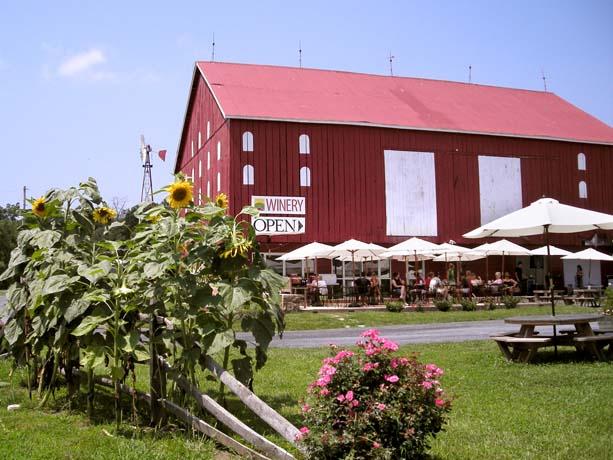Sugarloaf Mountain Day Trip
By • January 6, 2014 0 2787

Ah, Sugarloaf—what views as our cable car rises above the islands of Guanabara Bay! Sorry, wrong Sugarloaf. We’re not in Rio de Janeiro. We’re 10 miles outside Frederick, Md., on the border of Montgomery County.
Slightly shorter than the one in Brazil and much easier to get to, Maryland’s Sugarloaf Mountain presides over a scenic and historic landscape at the edge of the Blue Ridge.
Designated a National Natural Landmark in 1969, the quartzite monadnock is 1,282 feet high, some 800 feet higher than the surrounding farmland. A lookout point for Union and Confederate forces, it just missed becoming the Presidential retreat we know as Camp David.
Though “Camp Sugarloaf” admittedly lacks gravitas, it was the mountain’s owner, Gordon Strong, who persuaded FDR to look elsewhere (at nearby Catoctin Mountain, as it turned out).
Strong, who managed and inherited his father’s Chicago real estate holdings, earned law degrees from George Washington University (called Columbian University at the time) and worked as a patent attorney.
He started buying land on the mountain in 1903 and by the 1920s owned most of it. At Strong’s request, Frank Lloyd Wright designed an “automobile objective”—a sort of spiral, drive-up observation tower with a nightclub (or a planetarium, in a later version)—for the summit, but Strong finally decided to leave the ’Loaf alone.
He and his wife Louise founded Stronghold, the nonprofit that owns and maintains the mountain as a public park, in 1946, eight years before he died. Stronghold acquired more land and is working to restore the American chestnut to the park. The Strong Mansion, built in 1915, with patio and formal gardens, is rented out for weddings and banquets.
Admission is free to the park, which opens daily at 8 a.m. Hiking Sugarloaf Mountain is suitable for beginners and just challenging enough to interest those more experienced. Trails—satisfyingly uncrowded during the winter months—lead from the East View and West View parking areas.
At the base of the mountain, in the historic village of Comus (postal address: Dickerson), is Sugarloaf Mountain Vineyard, Montgomery County’s only vineyard-winery. Its fields are planted with the grape varieties of Bordeaux—Cabernet Franc, Cabernet Sauvignon, Merlot, Malbec and Petit Verdot—and the white-wine grapes Chardonnay, Pinot Grigio and Viognier. The vineyard opened in 2006. It’s received several awards and was chosen “Best of 2013: Vineyard ” by the Washington Post Express
Sugarloaf Mountain wines may be purchased at many shops in Frederick and Montgomery Counties and in D.C. at the Whole Foods markets in Foggy Bottom, Georgetown and Tenleytown. Their newest white, Penelope, sells at the vineyard’s tasting room for $23.95 per bottle and $263.45 per case. The tasting room is open seven days a week from 12 to 6 p.m. and closed on Christmas and New Year’s Day.
The nearby Comus Inn restaurant was originally the c. 1862 home of farmer Robert Johnson in what was then Johnsonville. During the Antietam Campaign, Union troops fired artillery at the Confederate position on Sugarloaf Mountain from the farm. The present five-bay main house, the handsome result of expansions in the 1880s and around 1900, incorporates Johnson’s chestnut log dwelling.
The view of Sugarloaf that made it a good place to fire your artillery makes the Comus Inn a popular wedding venue. The inn was a 2013 Wedding Wire Bride’s Choice and a Best of Weddings 2013 pick in The Knot.
In December, the inn is open for lunch Thursday to Saturday and dinner Wednesday to Sunday. The dinner menu is sophisticated country American, featuring steak, duck, pork, catch of the day, scallops and crab cake entrees, with family sides of iron skillet Applewood bacon cornbread with sweet sorghum butter, cast-iron baked macaroni and cheese and smoked tomato and cheddar Virginia stone-ground grits.
A few miles away, in Adamstown, is Lilypons Water Gardens, a leading plant and water garden supplier. It began in the early 1900s with G. Leicester Thomas, Sr.’s fondness for goldfish and water lilies. His hobby became a business, Three Springs Fisheries, in 1917. Eight years later, he expanded to 250 acres. The business thrived over the years to the point where a new post office was needed to handle Thomas’ blooming mail-order business. In 1936, the new post office was dedicated to Metropolitan Opera star Lily Pons, who was present for the festivities.
Thomas’ great-granddaughter, Margaret Thomas Koogle, now heads tthe company, which describes itself online as “Serenity for Sale.” Through February, Lilypons is open weekdays from 10 a.m. to 4 p.m. However, it is closed from Christmas to New Year’s Day. In March, it will be open seven days a week when many special events are planned.

